BEST TYPES OF LOGS
FOR WOOD BURNING STOVES
A common heat source for modern-day saunas is an electric sauna heater, but for sauna purists, a wood-burning stove tends to be the favored choice. A wood-fired sauna has a traditional feel with a crackling fire and temperatures that can reach up to 200 degrees Fahrenheit, making it one of the most efficient sauna types.

However, to build a fire that maintains the ideal sauna temperature, you must be sure you're using the best logs. You want your sauna to be as efficient as possible. If you’re unsure of the best types of logs for wood burning stoves, then keep reading. By the end of this article, you'll learn everything about the different types of logs you can use for your wood-burning sauna and which ones might be best for your purpose.
Why the Type of Wood You Burn Matters
Whatever choice you make for your wood-burning sauna, there are several factors to remember for an amazing conventional sauna experience. What you burn in your wood-burning stove is vital to your sauna's longevity and performance. Whether you use a delivery service or harvest your own firewood, understanding the pros and cons of various wood species will help you make the best choice. Wood species impacts how well your wood-burning stove performs in several areas.
Efficiency
Your wood stove's efficiency significantly depends on the wood type you're burning. Resinous (oily) woods and softwoods usually burn inefficiently. As a result, eucalyptus, aspen, pine, and others don't make the ideal firewood for a wood-burning sauna.
Appearance
Selecting firewood from a typically resinous wood might create a cloud of thick black smoke. This smoke clouds your stove's front glass, making cleaning the glass more difficult.
Reliability
Selecting resinous and soft firewood can negatively impact the reliability of your wood-burning stove. In addition, resinous firewood can also emit harsh chemicals on your wooden stove's internal parts, affecting its performance.
More precisely, it’s the catalytic combustor and the combustion fan of the catalyst that can be negatively impacted over time by resinous output. On the other hand, hardwoods provide lesser wear and tear on wood stoves making them the ideal logs for wood burning stoves.
Safety
Burning softwoods and resinous woods create a potential safety hazard in your home. These woods produce high amounts of creosote, which accumulates within the chimney and is the main cause of chimney fires in wood-burning stoves.
Softwoods vs. Hardwoods

Softwoods are ideal for kindling, while hardwoods are the preferred logs for wood burning stoves as they can maintain a slow-burning fire with excellent heat output.
Softwoods
Softwoods are from the conifer family trees. These are trees with needles, such as pine, cedar, and hemlock. Wood from softwoods catches fire easily and quickly but will produce more creosote than hardwoods. Softwoods are ideal for getting your fire going.
For instance, a few small pieces of pine make excellent kindling and, when minimally used, won't lead to the build-up of creosote. It's important to note that softwoods contain resin and sap that, when burned, leaves excessive creosote. Softwood can generate a pleasing flame to look at but burns quickly, meaning that you'll use a large wood volume in a short time.
Softwoods are often preferred for the following qualities:
-
They are a cheaper option
-
They're great for starting the fire
-
They absorb heat from the steam
-
They have a slower heating time with a faster burn
-
They can handle higher temperatures
-
They have a more pliable consistency
-
They're easier to cut and work with
Hardwoods
Hardwoods are wood types from deciduous trees. Deciduous trees have a slower growth rate than coniferous trees resulting in denser and harder wood.
Hardwoods can be harder to ignite from cold despite offering a more efficient fuel source. So, once you start your fire with softwood, you should fuel the fire with a hardwood, such as oak, to maintain a slow-burning fire with excellent heat output.
All types of wood should be well seasoned before burning. The best firewood should have a moisture content below 30% for burning. The wood density also determines how long it'll be seasoned. For example, oak, a very dense wood, can take up to 2 years to season completely.
The Best Type of Wood to Use for Your Wood-Burning Sauna Heater

You have various fuel options when it comes to a wood-burning sauna heater. While you can use any type of logs for wood burning stoves, as mentioned previously, hardwoods are better than softwoods when it comes to long-term burning. Any non-resinous hardwood can provide a good burn with dependable heat. The most recommended logs for wood burning stoves are the following:
Oak
Oak is well-known for its long, slow burns, making it the ideal firewood wood for your stove. Oak is a dense hardwood found throughout the North American region. Although it can take longer to be properly seasoned than other wood types, it produces the best fire for your stove. Oak is the top favorite and arguably one of the best logs for your wood burning stove.
Ash
Ash is easy to split and burns steadily, making it one of the best logs for your wood burning stove. It is primarily found in central and eastern North America, while also being readily available in other areas, such as the West Coast of the United States.
Ash is available in white and green varieties and maintains low smoke points. This makes favorite firewood for people who are sensitive to the smell of burning wood.
Maple
Maple firewood burns like Ash, and when correctly seasoned, it provides long and steady burns on your stove. Maple is found in the United States, making it a favorite firewood option for wood-burning stoves.
Apple
Apple wood produces an appealing smell with a low smoke output. Fruitwoods have appealing scents making them a popular logs for wood burning stoves. Apple is easy to split and needs a shorter seasoning time than other hardwood types. Moreover, apple has one of the highest BTU ratings of 27 per second.
Birch and Beech
Other common logs for wood burning stoves are birch and beech. These logs require a significantly longer seasoning time than most woods. Mostly, these woods are provided by kiln drying companies instead of those seasoning wood naturally. The best thing about these woods is that they have an intensely long burning time and a high BTU rating of 27 per second.
Other common logs for wood burning stoves include these softwood and hardwood types:
-
Alder
-
Blackthorn
-
Cedar
-
Cherry
-
Elder
-
Douglas Fir
-
Elm
-
Hazel
-
Hawthorn
-
Hornbeam
-
Holly
-
Larch
-
Horse Chestnut
-
Pear
-
Lime
-
Poplar
-
Plane
-
Spruce
-
Rowan
-
Sweet Chestnut
-
Walnut
-
Sycamore
-
Yew
-
Willow
The Best Way to Feed Your Outdoor Wood-Burning Sauna
If you have your own outdoor sauna, you can use an inside or an outside feed. Sauna experts recommend using an inside feed for the following reasons:
-
Inside feeding is convenient, visually appealing since you can look at the firelight, and it also makes cleanup easy.
-
Installing a chimney kit is cheaper than wall feeding, as metal clearances and framing will are required to set up an outside feed.
-
You can lose up to 25% of the heat in your sauna when using the outside feed, according to a Finnish sauna stove maker.
How to Stack Your Firewood
Let's look at some of the best ways to stack your logs for wood storage.

SIGN UP. SAVE BIG.
Subscribe to be the first to know about our special monthly sauna sales, sent right to your inbox.
Keep your logs as dry as possible
Always keep your logs and wood from getting damp or wet. Damp or wet logs won't burn or will emit excess smoke clogging your flue or even escaping into your room. So, cover your logs outside with a hard cover with a wood panel propped up at both ends. This keeps the rain off while allowing air to circulate, drying your logs and wood.
Avoid stacking your logs on the ground
Firewood requires constant air circulation to remain dry and combustible for the best burning. You can use an old wooden pallet as a base which contains many gaps for optimal air circulation.
Ensure your logs are covered
Although your logs are covered, ensure at least one side is open. This is especially important if using polythene as the cover because the logs need to breathe to prevent sweating. On the other hand, if you keep your logs indoors, you should use a log holder or indoor storage. A great way to keep your logs off the ground, dry, and covered is to use a specific wood barrel storage (pictured above).
Summary
While you can use any wood type for your wood-burning sauna, as you have learned in this article, some types of wood are better than others. Softwoods are better for starting or initiating your fire, because of their faster and hotter burn time. Common softwood types include cedar, redwood, spruce, fir, and pine. Hardwoods are better for keeping your fire going at a steady rate, due to their long, slow burn and ability to endure drastic temperature changes. However, they can be more expensive. The most common types include maple, oak, cherry, poplar, birch, and walnut. As a precaution, avoid wood containing sap and do not use wood that is green, stained, or that has been painted.
Looking for the perfect wood-burning sauna stove to get started? Check out our collection of wood burning sauna stoves and traditional outdoor saunas. If you have any questions about wood burning sauna needs, our team is always here to help.

About the Author
Adam Fromson
Adam Fromson, co-founder of My Sauna World, loves saunas and their transformative health benefits. With years of experience exploring sauna culture and its impact on health and wellness, Adam is passionate about helping others discover the life-changing benefits of saunas for themselves.
Let customers speak for us
from 385 reviews
Good communication, easy delivery, easy set up, easy operation, great value. Recommended!
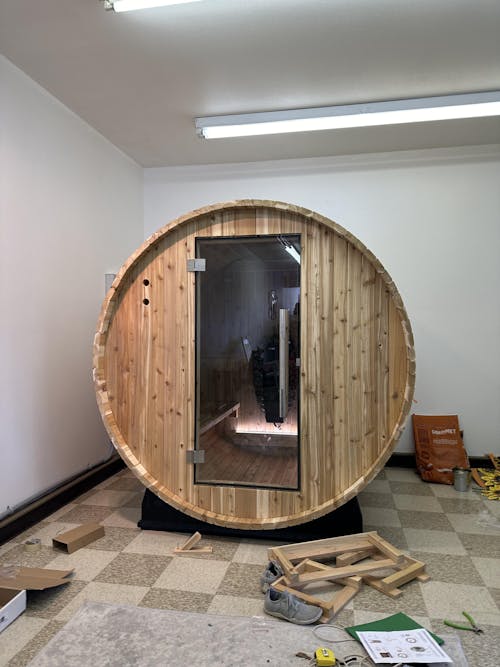
We ordered the 4 person barrel sauna and love it! We wanted a little extra space for the 2 of us/guests and it’s great. We could definitely fit 4 people in it if we needed. We use it every single day. It took about 10 weeks to get here because they build it specifically for the order. Putting the barrel together was fairly easy with 2 people. The electrical and the heater definitely required an electrician to install as we could have not done it alone.
We ordered the biggest heater (harvia spirit 8kw) and it heats up the sauna in about 15 mins inside our 40-50° garage. Overall this style of sauna is hotter and you sweat a lot faster than in an infrared sauna. I truly 10/10 recommend!
Pic is of us in the middle of building it.
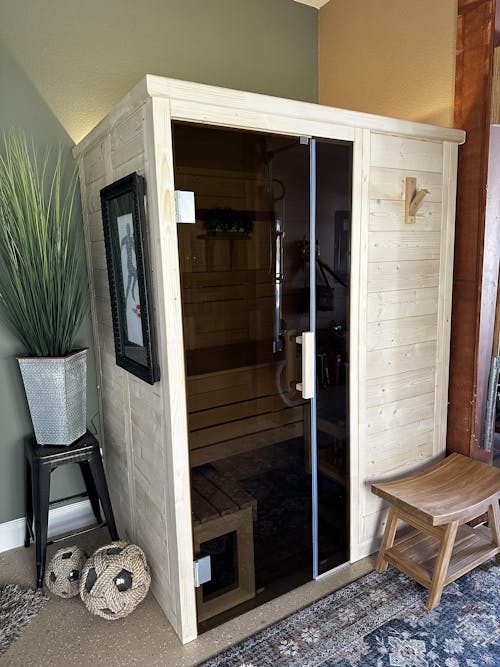
Took me about 6 hours over 2 evenings to assemble almost all by myself. Had a pro run a new circuit from my panel. Very well made and assembly was straightforward. Heater is well sized and reaches operating temperature in under 30 minutes.
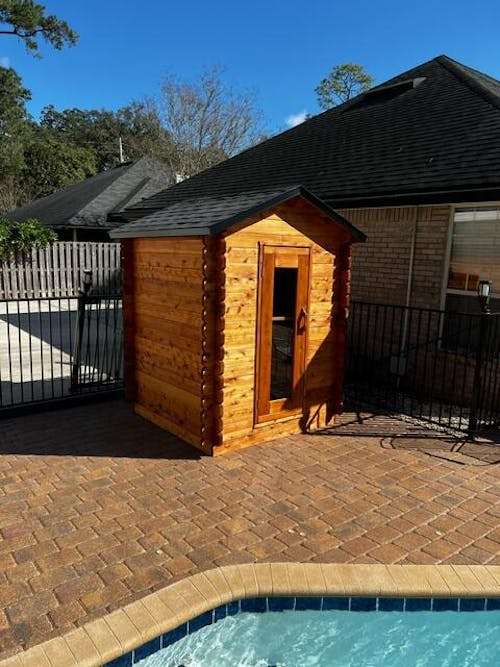
Great sauna very easy to assemble
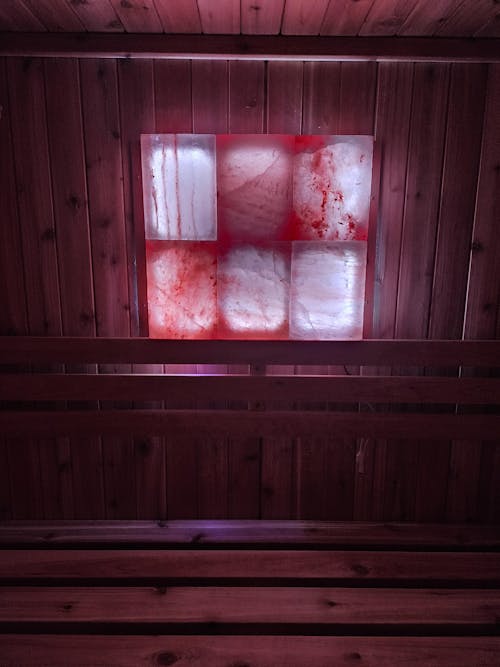
The salt panel was a great addition to our Madison Sauna. It has excellent grain which is accented by the amazing color lights that glow through the panel. Also when you hit the rocks with a splash of water you can feel the heat bounce off the panel. Great addition if you are considering this option.
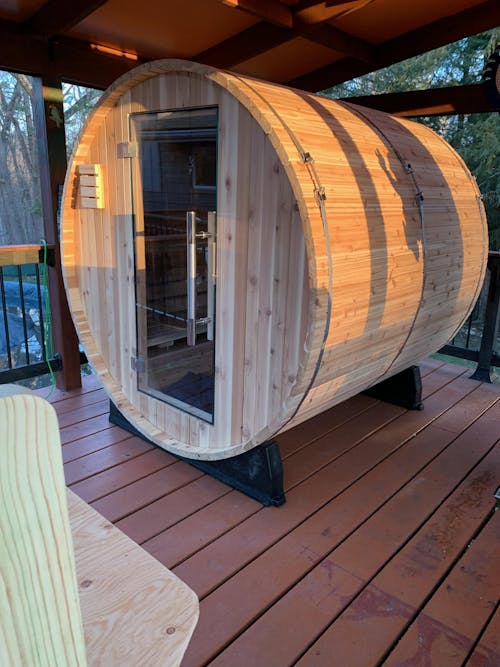
We can say enough about Sauna World there customer support is great! Our Pinnacle Sauna from Almost Heaven is epic.
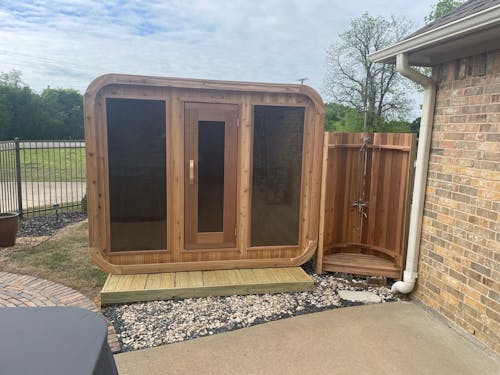
The finish and quality is outstanding and it was quick and easy to assemble.
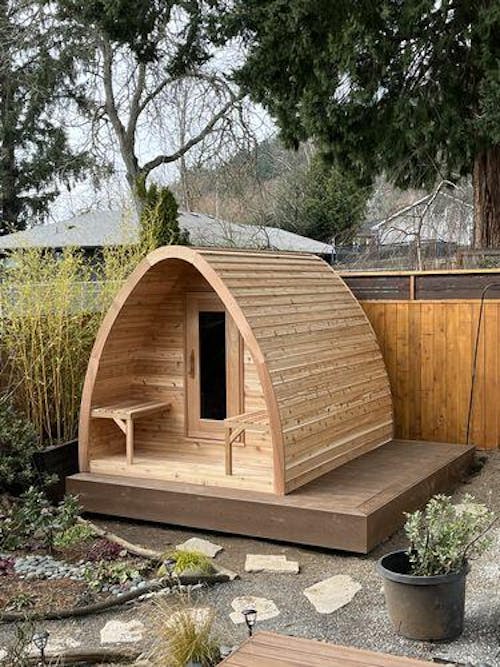
We are thrilled with our mini pod!! It came well shipped and our friend assembled it in 11 hours! Wow! We cannot wait to get healthy and sauna it up!
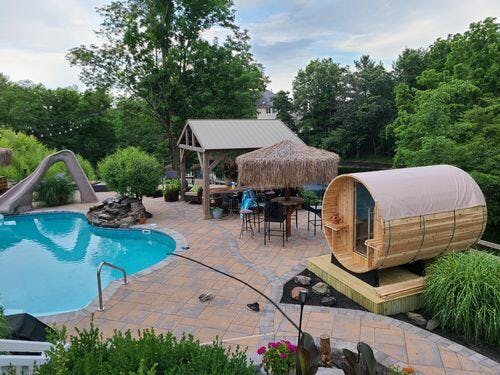
Beautiful sauna!!! Much easier than I expected to assemble, took a total of 4 hours. Can't wait to get warm by the pool on those cool evenings. Customer service was excellent..

Purchased a 2 person Almost Heaven barrel sauna and were delighted with the product. The order process was quick and easy, the sauna arrived on-time, installation was simple, following the provided instructions, and the sauna is extremely high quality. We’ve used it daily for over 2 weeks and quite frankly I don’t know how we lived without it. If I had it to do over again I wouldn’t change a thing... except maybe purchasing a 4 person model to easier share with friends!
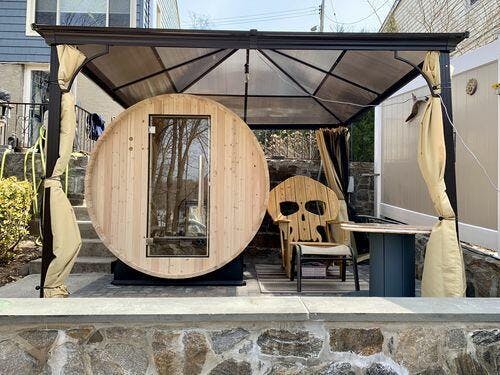
Great Customer Service and a breeze to put together.Excellent shipping and the Sauna is top notch, couldn’t be happier






























